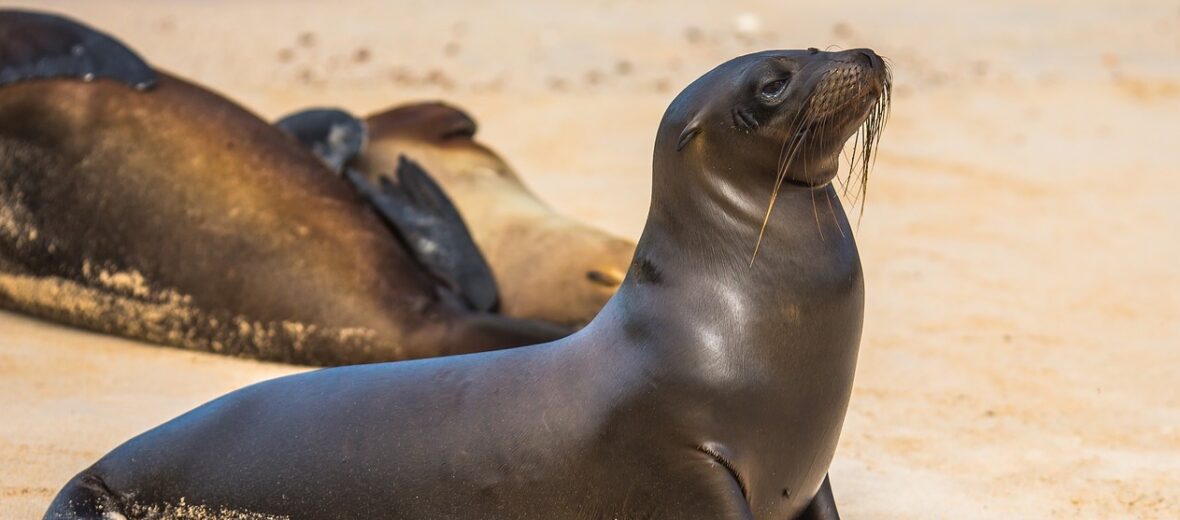
The sea lion looks like a seal, but there are a couple differences. Seals, sea lions, and walruses are in a scientific group of critters called pinnipeds, which means “feather foot” or “wing foot”. The wet “staining” is from their eyes watering to remove salt water from their eyes. “I’m not crying. My eyes are just a little sweaty.” These fascinating creatures can be found in oceans all over the world, sans the Northern Atlantic Ocean. This is not yet understood. There are 7 known species of sea lion with the Stellar sea lion being the largest of them all. Some of these lions of the ocean are on the IUCN list as nearing extinction, for various reasons. Mostly bycatch and pollution.
First the Stats…
Scientific name: Otariinae
Weight: Up to 2,200 lbs.
Length: Up to 10 feet
Lifespan: Up to 30 years
Now on to the Facts!
1.) These cool critters can dive up to 600 feet in search of food.
2.) They are able to hold their breath for up to 40 minutes at a time.
3.) Males are significantly larger than females making them sexually dimorphic.
4.) Like other marine mammals, they have a thick layer of blubber to keep them warm in the cold ocean.
5.) As is the case with all mammals, as they age, they can succumb to age related ailments like cancer, pneumonia, and even epilepsy.
But wait, there’s more on the sea lion!
6.) To tell the difference between a seal and a sea lion, just look at the ears and hind flippers. They have ear flaps whereas seals have ear holes. Sea lions can also rotate their hind flippers forward to aid in land-based movement.
7.) The New Zealand sea lion is the rarest of all the species and is listed as Endangered by the IUCN.
Did you know…?
They are speedy! Sea lions can reach bursts of 25 mph. Their standard aquatic traveling speed is about 5 – 10 mph though.
8.) Not only do they have the big brown puppy dog eyes but, being mammals, they also produce milk to nurse their pups, just like all other mammals.
9.) They have pretty good aquatic vision thanks to a special reflective membrane at the back of their eyes. Their sense of hearing and smell are pretty keen too.
10.) If you ever see a strange looking group of dark “fins” sticking out of the water in harbors, it’s typically just sea lions sticking their flippers into the air to cool off. They have a vascular network in their front flippers that constrict to keep warm and enlarge to allow for cooling.
But wait, there’s still more on the sea lion!
11.) Primary menu items include fish and squid.
12.) They are preyed upon, primarily, by sharks and orcas. They also unfortunately meet their demise at the hands of fishing nets. This is called bycatch.
13.) Plastic also poses a huge problem for these wonderful creatures. Plastic bags, underwater, can resemble squid. They are then consumed and are unable to be passed. This blockage ultimately causes a slow painful death.
Did you know…?
Never approach a colony of sea lions. They can be dangerous! Males have no qualms about defending their harem with lethal force.
14.) Males watch over a harem of females and protect them ferociously. Rival males will often try their hand at challenging the alpha bull and occasionally win the battle and the subsequent harem. The losing bull will leave in shame. Sometimes the new bull will kill the existing pups in order to replace the colony with his offspring.
15.) A female’s gestation lasts between 8 – 11 months and she will give birth to a 50 lbs. pup. This bouncing baby will grow to 200 lbs. & 6 feet long by the time they are just a year old!
Now a Short Sea Lion Video!
Also, check out the Critter Science YouTube channel. Videos added frequently!
Want to suggest a critter for me to write about? Let me know here.



